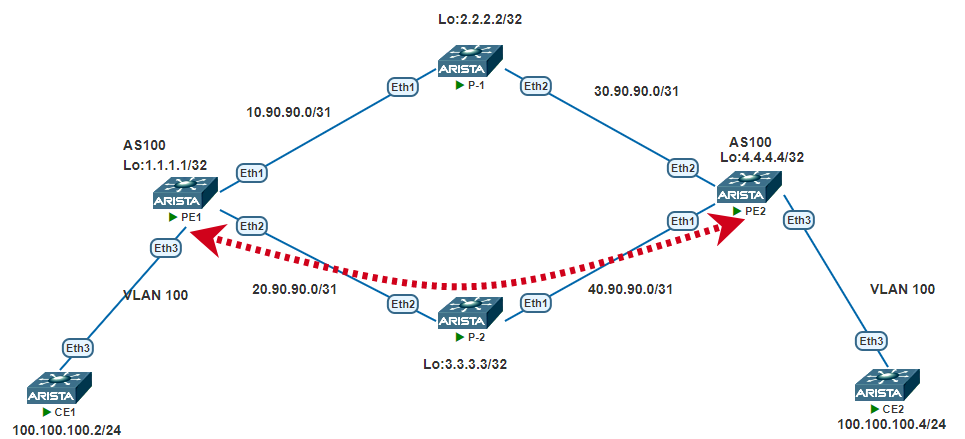Today, we will examine VPWS technology in Arista. Virtual Private Wire Service (VPWS) is based on point-to-point communication in your MPLS environment. There is similar technology whose name is LDP Pseudowires. In this technology, PE devices are signalled via LDP. There is also another technology VPLS. VPLS provides communication on point-to-multipoint by using either BGP signalled or LDP signalled.
Now, let’s focus to Virtual Private Wire Service (VPWS) which is on EVPN-MPLS. Why is EVPN needed? As you remember, EVPN uses route-types. With the help of EVPN, we are able to communicate two points of customer as point to point with Auto-Discovery route type of EVPN. We say type 1. As you see there is no need mac address informartion advertisement in this technology. So main purpose is to not handle mac addresses advertisement. The most critical point is this.
If you like to read RFC (you should), you can visit RFC8214 for details of the technology. We share below configuration statements.
You can use direct port or subinterface for VPWS to attachment circuits. We have used here subinterface of ethernet 3. You can use different VLANS in each side. But here we have used VLAN 100.
Configuration Steps
Build MPLS in your enviroment
We enable OSPF for IGP protocol and advetised loopback IPs to each other in PE and P routers. PE routers are mpls ingress and egress routers.
Enable mpls with “mpls ip” command in 4 routers.
PE-1 OSPF Config, All routers has same config statements.But you can change cost of interfaces to define path from PE-1 to PE-2 as in diagram with red arrow.
router ospf 1
router-id 1.1.1.1
passive-interface Loopback0
network 1.1.1.1/32 area 0.0.0.0
network 10.90.90.0/30 area 0.0.0.0
network 20.90.90.0/30 area 0.0.0.0interface Ethernet1
ip ospf cost 40Enable LDP protocol in 4 routers by using below command.
mpls ldp
no shutdown
PE-1#show mpls ldp neighbor summary IBGP connectivity between PE-1 and PE-2. Also enable EVPN under this IBGP.
router bgp 100
router-id 1.1.1.1
neighbor 4.4.4.4 remote-as 100
neighbor 4.4.4.4 update-source Loopback0
neighbor 4.4.4.4 send-community
address-family evpn
neighbor default encapsulation mpls next-hop-self source-interface Loopback0
neighbor 4.4.4.4 activateConfigure patch panel config on PE-1 and PE-2
PE1-PE2
patch panel
patch CUSTOMER
connector 1 interface Ethernet3.100-------->Same subinterface will be used on PE1 and PE2.
connector 2 pseudowire bgp vpws evi-1 pseudowire pw1Configure VPWS config on PE-1 and PE-2
PE-1
router bgp 100
vpws evi-1
rd 1.1.1.1:1
route-target import export evpn 100:1
mpls control-word
!
pseudowire pw1
evpn vpws id local 100 remote 101----> local and remote should not be same.PE-2
router bgp 100
vpws evi-1
rd 4.4.4.4:1
route-target import export evpn 100:1
mpls control-word
!
pseudowire pw1
evpn vpws id local 101 remote 100OUTPUTS
PING and MAC result of CE-1
CE-1#ping 100.100.100.4
PING 100.100.100.4 (100.100.100.4) 72(100) bytes of data.
80 bytes from 100.100.100.4: icmp_seq=1 ttl=64 time=80.0 ms
80 bytes from 100.100.100.4: icmp_seq=2 ttl=64 time=107 ms
80 bytes from 100.100.100.4: icmp_seq=3 ttl=64 time=142 ms
80 bytes from 100.100.100.4: icmp_seq=4 ttl=64 time=166 ms
80 bytes from 100.100.100.4: icmp_seq=5 ttl=64 time=162 msCE-1#show mac address-table vlan 100100 50fd.0b81.8c5e DYNAMIC Et3 1 0:01:46 agoPE1 EVPN ADVERTISEMENT ( Please check no mac address advertisement only Ethernet Auto-Discovery)PE-1#show bgp neighbors 4.4.4.4 evpn advertised-routes Network Next Hop Metric LocPref Weight PathPE-1#show bgp neighbors 4.4.4.4 evpn routes
> RD: 1.1.1.1:1 auto-discovery 100 0000:0000:0000:0000:0000
1.1.1.1 - 100 0 i Network Next Hop Metric LocPref Weight Path> RD: 4.4.4.4:1 auto-discovery 101 0000:0000:0000:0000:0000
4.4.4.4 - 100 0 iPE-1#show mpls lfib routeLP 132768 [1]
via P, patch CUSTOMER, control word
interface Ethernet3.100, type 5